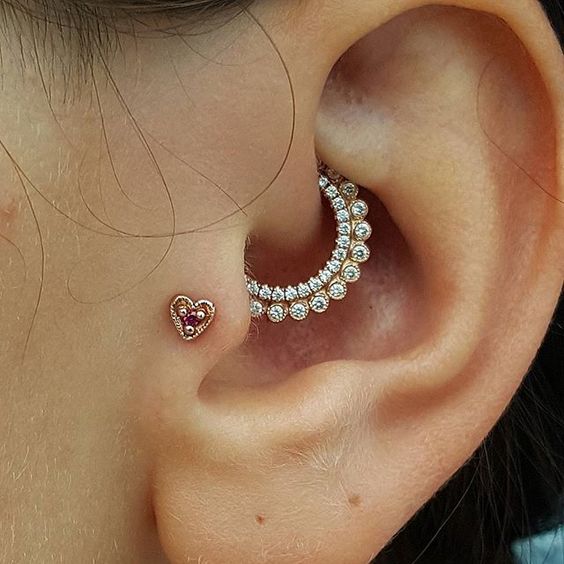Ear piercings have been popular for centuries and there’s so much you need to know. The human ear has 14 different areas in which it can be pierced in. These different areas each come with different pain levels due to extra sensitivity. We explain everything you need to know about the different types of ear piercings.
Standard lobe piercing
The standard lobe piercing is the most customary piercing that you can get. Most people start out with a standard lobe piercing before trying any other area on the ear. This specific piercing heals quickly and isn’t too painful.
The lobe area can be pierced multiple times and some often choose to pierce both the upper and lower lobe. If you choose to have a lobe piercing it’s always best to choose a captive bead ring or a segment ring. This allows the ear to heal (even if it swells) without putting pressure on it.
Transverse lobe piercing
Transverse lobe piercings go through the skin in a horizontal direction. The surface of the lobe is pierced at an angle and the piercing goes in from one side and out the other. Generally speaking, this isn’t too painful.
The type of earing used for a transverse piercing is a straight barbell. There is also the risk of the barbell migrating out and causing damage to the earlobe.
Upper lobe ear piercings
Upper lobe piercings are directly above the standard lobe piercing. This piercing isn’t painful because it doesn’t involve any cartilage
Antitragus piercing
The antitragus is situated next to your lobe and does have a little bit of cartilage. With regard to the pain level, this might be painful for those who have a low pain threshold.
Typically speaking, surgical steel, BioPlast, and labret studs are the best to use for antitragus piercings.
Conch piercing
Conch piercings consist of the inner conch or the outer conch. This area is situated above the lobe area where there’s only cartilage. It’s best to use a labret stud when piercing the conch area. Make sure not to twist or slide the earring, this could cause a mild irritation.
Orbital piercing
An orbital piercing is two piercings that are made in the same part of the ear. A hoop is placed through the two holes and can be described as though its “orbiting” the ear. The main types of earrings used for orbital piercings are captive rings and segment rings.
Snug piercing
A snug piercing requires a small captive bead ring that is placed on the rim of the cartilage. It is also known as a piercing of the antihelix.
Industrial ear piercings
The most common sort of industrial ear piercings is a piercing through the antihelix and helix. This piercing goes through the ear cartilage and is connected with a long barbell. It is also known as a scaffold piercing.
Helix piercing
Helix ear piercings are on the outer top rim of the ear; on the cartilage area. People often get more than one piercing here, even though it is really painful.
Captive rings are the best starter option for this area because they are so comfortable. Once the ear is healed you can change to a spiral ring.
Rook piercing
A rook piercing is on the same rim of the ear as the snug piercing. Choosing an earring for this area is always fun and you can choose from either a hoop (captive or segment ring) or a barbell.
Forward helix piercing
The forward helix is one of the more painful areas to get an ear piercing, but it’s totally worth it. The ear is pierced on the outer rim of the ear, where the helix connects to the head. It’s advisable to use a small labret stud.
Tragus piercing
The tragus area is one of the more popular areas to get a piercing. The pain levels might be slightly higher, especially when lying down in the area. The inner piece of the cartilage (over the ear canal) is pierced with a stud or a hoop, although it’s best to use a stud first.
Daith ear piercings
A daith piercing is positioned where the helix connects to the head, above the tragus. The cartilage here is very sensitive and piercing this area is painful. Captive bead rings are perfect for this area and they look incredible too!




